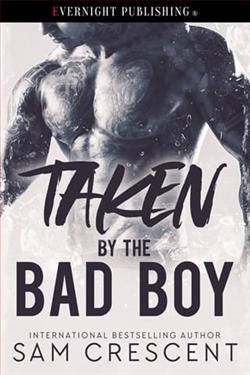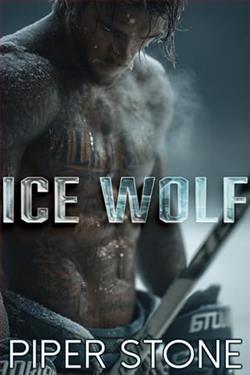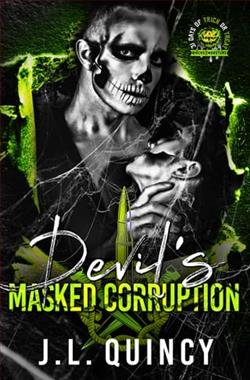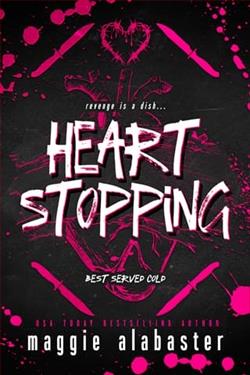Page 125 of The Testing (The Testing 1)
One of the officials who brought the files spots me as I reach the third floor. She asks if I need help with my work, and I tell her I finished the assignment and am going home. With a wave, I continue down the next two flights, hoping she isn’t one of Symon’s rebels.
More officials are in the halls on the first floor than when I arrived. I keep my head down and walk to the exit. The fresh air feels cool and wonderful against my skin as I grab my bicycle and begin to ride. I try not to think about the president’s request, but it is impossible to forget what she has charged me to do. Dr. Barnes. Professor Holt. Symon. Raffe’s father. All people who have had a hand in killing Testing candidates either by active participation or passive acceptance. They deserve to be punished for their parts in the deaths of those who came here in hope. But do their actions mean they deserve to die? And if so, can I bring myself to kill them?
My stomach heaves as I recall the feel of Damone’s blood running over my hand while life drained from his body. If the president has her way, his will be just the first blood I shed. I try to tamp down the nausea, but after three blocks, I jump off my bike and run toward a group of bushes huddled near the side of a sandy-colored brick building. My bike clatters to the walkway behind me as I empty my stomach onto the ground. I wipe my mouth and try to stand up straight. But my stomach tightens again and I hunch over. My legs feel like jelly. Sweat breaks out, and I start to shake as the images of those who have died run through my mind. Ryme’s empty eyes. Roman’s bloody body. Michal’s face as it drained of color just before he crumpled to the ground.
Slowly, the shaking subsides and I straighten. I take careful steps. The weakness I felt seems to have passed, but when I pick up my bike, I choose to walk with it down the city street instead of riding. I fumble with the fastenings on my bag and dig out a bottle of water. The water cleanses my mouth and throat of the taste of bile, but it cannot wash away the cause. I wheel my bike north while taking sips of water, not paying attention to where I am headed. When I come to a small fountain in the middle of a grassy area surrounded by a small square of shops, I set my bike on the ground and take a seat on the stone lip of the fountain.
It is cool, but the early evening light has encouraged many to come out of doors. Children play a game of tag. Several couples sit on benches along the walkways that surround the park. Everything seems so normal. No one here feels the tension of the power struggle that is about to threaten their world.
I pull the Transit Communicator out of my bag, hit the Call button, and close my eyes as I wait for Zeen to respond. But no matter how much I want to hear his voice, the Communicator remains silent and I have no idea what I should do now. I went to the president so she could save him and everyone else from Dr. Barnes, Symon, and the destruction the false rebellion will cause. She was supposed to take charge and solve this problem. Instead, she has turned it back on me and I am not sure I am capable of walking the path she has pointed me toward.
Swallowing hard, I open my eyes and stare at the clean, clear water gurgling next to me. The fountain is not simply decorative but is used by citizens to fill their drinking bottles, and I find myself thinking of the people who survived the Seven Stages of War. The fear they must have felt when the South American coalition attacked. When President Dalton responded by ending the stance of isolationism he’d adopted in hopes that avoiding conflict would bring peace. It didn’t. Nor did the violence that came after. Cities around the world were leveled. Millions killed. Finally, leaders decided to lay down their weapons before they destroyed not only their enemies but themselves. The Fourth Stage of War ended and peace treaties were signed.
Despite the devastation, there must have been a sense of hope. A feeling that the worst was over. But the earth did not sign a treaty. The biological and chemical warfare employed during the first Four Stages could not be wiped away with the stroke of a pen. Peace would not be so easy. Earthquakes. Chemical-laden rainstorms. Floods. Tornadoes. Hurricanes. By the time the Seventh Stage of War ended, the weather and landscape had been unimaginably changed.
It’s amazing that humans survived. How easy it would have been to look at the horror around them and give up. Food was scarce. Uncontaminated water was almost impossible to find. But they didn’t surrender. They salvaged what they could from their homes and set out to find other survivors. They came here. They revitalized this city. Brick by brick, tree by tree, they began to restore what their leaders had destroyed.
There must have been terrible choices to be made. People who refused to endorse a centralized government created trouble. They hoarded resources. Caused fights on the Debate Chamber floor and turned the focus away from the good of everyone to themselves. City officials encouraged them to leave Tosu. Eventually, they did.
When my Five Lakes classmates and I were studying this part of history, our teacher told us that the dissenters disappeared from the city. I assumed she meant that they set out to find a new place where they could live as they chose. Now I wonder. Would those intent on bringing down the newly created government have been able to leave so easily? Especially when their dissent was causing the governing body so much trouble? There were food riots. Solar panels were destroyed or stolen. Vigilantes patrolled the streets, fighting with and sometimes killing those the government had assigned to ensure their safety. With a shortage of resources and a flurry of lawlessness, there must have been concern that the new government was flawed. That it was not in control. That, maybe, not following the new rules for resource distribution and revitalization would make things better.
How difficult those days must have been. With new food resources available and plants and trees thriving in the revitalized soil, it seems impossible to imagine that anyone could have believed trying to survive on their own would be better than working together and following the same rules. But quite a few did. Yet somehow the government regained control. In order to do so, did they eliminate those who were intent on wreaking havoc?
Maybe.
If so, were they wrong?
I look at the sparkling, uncorrupted water and then at the children laughing as they play. Would these things be here now if the dissenters had destroyed what was just being created? Does this end justify a means paved with blood?
I don’t know.
At one time I would have been certain. This situation would have appeared black and white. I wish it did now. I told President Collindar that I could not eliminate those whose names are written on
the paper in my bag. I want to believe that this is the truth, but the pressure I feel growing in my chest as I look around at a city that was forged in struggle and in hope makes me wonder whether there might be another truth. That like the Seven Stages of War and the time that followed, peace will come accompanied by sacrifice and death.
I glance at the watch on the strap of my bag. The sun will soon be setting. I need to return to campus. I know I should get on my bike and return, but I find myself pulling the gray folder out of my bag again and opening it. There are the twelve names, the code to the fifth-floor room, and the note President Collindar wrote to me. Under that page are several more sheets of gray recycled paper. Eleven of them, to be exact. One for each of the original eleven names on the president’s list. At the top of each page is a name followed by the person’s residence, family information, and role in The Testing.
Not surprisingly, the first page of this group centers on Dr. Jedidiah Barnes. The location of his home means little to me, since I am not from Tosu City. Although I do remember other students mentioning that his personal dwelling is on one of the streets that surround the University campus. I read the name of his wife and picture the woman I met last summer, after The Testing was over. His two children are sixteen and twelve—approaching the age when they can apply to the University. With their father as head of the program, they no doubt would be selected. But will they want to be a part of the trials that follow? Dr. Barnes has been in charge of The Testing for fifteen years. During that time, 1,132 students have sat for The Testing. Of those, 128 were passed through to the University. Over one thousand students who wished to help the world are gone. Because of him.
As the light fades, I read through the other pages, committing as much as possible to memory. Professor Holt—an advocate for adding another section to The Testing to push the ability of students to think critically while under emotional strain. Professor Markum—head of Medical studies, who created the newest version of the memory-erasure serum and is working on a neurological implant to help officials better monitor the way each prospective student deals with the strain of The Testing process. Professor Lee—who, according to this information, not only helped create the scoring system for each group of students during the first round of The Testing but is advocating for a larger pool of candidates to ensure that none of the best and brightest escape notice.
Page after page of leaders. All working to make The Testing harder. More invasive. Deadlier.
White-hot anger builds inside me as I start over and reread the descriptions by the fading light. These people were entrusted with the lives of the next generation of leaders. They have betrayed not only that trust but also the faith of the entire country.
Emotions cloud my vision, making it hard to read through the last few pages. Rage. Sorrow. Fear. Despair. They chip away my resolve to refuse the president’s request and pull at the beliefs I have been taught to hold dear. When I finally finish my second read, I slide the papers back into the folder, fill my water bottle at the fountain, and climb onto my bike. Using the Transit Communicator to guide me, I head back to the University, taking the same path I used to get to the president’s office. The route isn’t the most direct, but getting back quickly isn’t my purpose. While I would prefer to destroy the papers the president gave me, there is a chance I will have need of the information they contain. Hiding them so I cannot be caught with them is my best option.
I spot a neighborhood where the roads and sidewalks are cracked and broken and the grass less green, and turn to enter it. The roofs of the houses sag in the middle. Boards across windows and doors signal a lack of materials to make repairs. Stairs are missing steps. Swirls of faded paint decorate the houses’ exteriors. The front yards are mostly dirt with a few patches of scraggly yellowish grass. If it weren’t for the hopeful budding of the healthy trees on the street, I would think this area had yet to be revitalized and that people did not yet live here. But they do. A rag doll sitting near the rotted front steps of a squat brown house with a porch that is carefully swept of debris and a metal shovel that is free of rust sitting outside another dwelling tell me that people are here.
Since coming to Tosu, I’ve realized that despite the best intentions of the government, it is almost impossible for a city this size to treat all citizens the same. Streets that government officials call home are repaired more frequently than those of people who do not hold influential jobs. But the run-down appearance of some areas notwithstanding, I have never seen another so poorly tended as this one. While that disturbs me, in a way I am glad. It’s clear that the government rarely if ever notices this street, so it could be a perfect place to hide the papers I don’t want anyone to find.
In the last rays of daylight, I study the dilapidated, graffiti-laden houses on either side of the roadway, ignoring those that show signs of habitation. A small one-story structure with boarded-up windows and a sagging roof catches my eye. The houses across from it show subtle signs of occupancy, but this one and the two on either side look as though nothing but rodents and small animals have gone near the front door in months.
Careful to keep to the grass so I don’t leave footprints in the dirt, I cross to the back of the house. The door in the rear hangs precariously from its hinges. I can see at least one spot where an animal has constructed a nest in the eve of the roof.
I lean my bicycle against the back of the house and walk to the door. The hinges let out a shrill protest as I shift it open. I go still and wait to see if anyone appears. When no one does, I walk inside into a small kitchen. Doors of cabinets are missing. In the center of the room, the remains of a collapsed table lie sprawled on the floor, surrounded by three wooden chairs. Leaves and twigs are scattered on the ground. Still, I search the rest of the structure to make sure this place is not in use.
The living room floor is coated in a thick layer of dust. The lone sofa in the room is so worn that springs poke through its cushions. I search the bathroom and two bedrooms. When I see no obvious signs of habitation, I pull my pocketknife out of my bag, then open the bedroom closet. Kneeling, I use the knife to prod around the floorboards. Several are loose. I pry up three, stand up to pull the folder out of my bag, remove the list of names, and tuck the rest of the papers into the spot I dug out. I replace the floorboards and pile the clothes stained with Damone’s blood on top of them. Then I close the closet door and hurry out.















